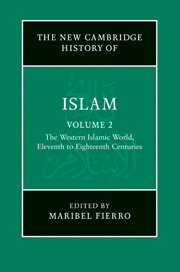Book contents
- Frontmatter
- Introduction
- PART I AL-ANDALUS AND NORTH AND WEST AFRICA (ELEVENTH TO FIFTEENTH CENTURIES)
- 1 Al-Andalus and the Maghrib (from the fifth/eleventh century to the fall of the Almoravids)
- 2 The central lands of North Africa and Sicily, until the beginning of the Almohad period
- 3 The Almohads (524–668/1130–1269) and the Ḥafṣids (627–932/1229–1526)
- 4 The post-Almohad dynasties in al-Andalus and the Maghrib (seventh–ninth/thirteenth–fifteenth centuries)
- 5 West Africa and its early empires
- PART II EGYPT AND SYRIA (ELEVENTH CENTURY UNTIL THE OTTOMAN CONQUEST)
- PART III MUSLIM ANATOLIA AND THE OTTOMAN EMPIRE
- PART IV NORTH AND WEST AFRICA (SIXTEENTH TO EIGHTEENTH CENTURIES)
- PART V RULERS, SOLDIERS, PEASANTS, SCHOLARS AND TRADERS
- Glossary
- Bibliography
- Index
- References
4 - The post-Almohad dynasties in al-Andalus and the Maghrib (seventh–ninth/thirteenth–fifteenth centuries)
from PART I - AL-ANDALUS AND NORTH AND WEST AFRICA (ELEVENTH TO FIFTEENTH CENTURIES)
Published online by Cambridge University Press: 28 March 2011
- Frontmatter
- Introduction
- PART I AL-ANDALUS AND NORTH AND WEST AFRICA (ELEVENTH TO FIFTEENTH CENTURIES)
- 1 Al-Andalus and the Maghrib (from the fifth/eleventh century to the fall of the Almoravids)
- 2 The central lands of North Africa and Sicily, until the beginning of the Almohad period
- 3 The Almohads (524–668/1130–1269) and the Ḥafṣids (627–932/1229–1526)
- 4 The post-Almohad dynasties in al-Andalus and the Maghrib (seventh–ninth/thirteenth–fifteenth centuries)
- 5 West Africa and its early empires
- PART II EGYPT AND SYRIA (ELEVENTH CENTURY UNTIL THE OTTOMAN CONQUEST)
- PART III MUSLIM ANATOLIA AND THE OTTOMAN EMPIRE
- PART IV NORTH AND WEST AFRICA (SIXTEENTH TO EIGHTEENTH CENTURIES)
- PART V RULERS, SOLDIERS, PEASANTS, SCHOLARS AND TRADERS
- Glossary
- Bibliography
- Index
- References
Summary
Historiographic remarks
In 609/1212, the caliph al-Nāṣir was defeated at Las Navas de Tolosa. Over the decades that followed, the Almohad empire underwent a slow disintegration to give way to the Naṣrids in al-Andalus, the Banū Marīn in the western Maghrib, the Zayyānids or ʿAbd al-Wādids in the central Maghrib and the Ḥafṣids in Ifrīqiya. These dynasties followed common trends and faced common challenges.
From an economic point of view, the establishment and expansion of the three great North African states, as well as the conflicts between them, can be explained by the importance of the trans-Saharan trade routes and the need to have access to the cities that controlled these routes and the ports that provided outlets for them. Relations between these states and the Christian lands across the Mediterranean revolved around this trade, and their complexity is illustrated by the struggle for control of the Straits of Gibraltar.
The Almohad political inheritance demanded particular responses from each of them. While the Ḥafṣids claimed to have inherited the caliphate, the other dynasties had to find alternative solutions to the question of political legitimacy, constructing ideologies that would make sense within the political and religious developments that were then taking place in the Muslim west. For example, both the institutionalisation of scholarship through the foundation of colleges (madrasas) and the institutionalisation of the mystical brotherhoods very much need to be seen within a political framework.
- Type
- Chapter
- Information
- The New Cambridge History of Islam , pp. 106 - 143Publisher: Cambridge University PressPrint publication year: 2010
References
- 2
- Cited by

